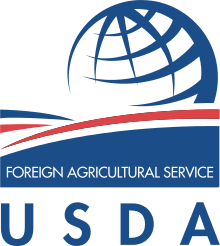Foreign Agricultural Service
This impeded their work, which at that point consisted mainly of collecting, analyzing, and transmitting to Washington time-sensitive market information on agricultural commodities.
[5] The analytical unit in Washington, by the early 1920s supervised by Leon Estabrook, deputy chief of USDA's Bureau of Agricultural Economics, compiled publications based on reports from the USDA's overseas staff, U.S. consuls abroad, and data collected by the Rome-based International Institute of Agriculture.
[6] In 1924, USDA officials Nils Olsen and Louis Guy Michael and Congressman John Ketcham began drafting legislation to create an agricultural attaché service with diplomatic status.
In Washington, Hobson hired Lazar Volin, a Russian émigré, as the agency's first D.C.-based regional analyst, to specialize in the study of Russia as a competitor to U.S. agriculture.
On July 1, 1939, however, President Franklin D. Roosevelt ordered all diplomatic personnel, including the agricultural attachés and commissioners, transferred to the Department of State.
During this period OFAR also led negotiations that resulted in creation of the International Wheat Council, and began assisting Latin American countries to develop their agriculture.
[15] After the war OFAR was instrumental in carrying out land reform in Japan and offering agricultural technical assistance under the Marshall Plan and the Point Four Program.
The intent of these efforts was first, to combat communism; second, to promote export sales of U.S. agricultural products; and third, to improve diets in foreign countries through extension of technical assistance and technology transfer.
[18] In April 1954, FAS handed off national security–related technical assistance to the International Cooperation Administration (USAID's forerunner) and began to concentrate on foreign market development for U.S. agricultural commodities, signaling a radical shift in the agency's focus.
Agricultural attachés began negotiating agreements for concessional sale of U.S. farm commodities to foreign countries on terms of up to 30 years and in their own local currencies.
[20] In 1955, FAS began signing cooperative agreements with groups representing American producers of specific commodities to expand foreign demand.
[21] In 1961, the General Sales Manager of USDA's Commodity Stabilization Service (CSS) and his staff were merged into FAS, bringing with them operational responsibility for export credit and food aid programs.
[23] In 1969, the General Sales Manager and his staff were split off to form a separate USDA agency, the Export Marketing Service (EMS).
[26] In 1981 the Ronald Reagan Administration abolished the Office of the General Sales Manager and formally restored its status as a program area of FAS.
Trade tensions with the European Economic Community (EEC) boiled over in 1962 with the first "Chicken War", a trade dispute arising from the EEC's application of protective tariffs on poultry meat imported from the United States in retaliation for President Kennedy's imposition of a ceiling on textile imports and raising of tariffs on carpets, glass and bicycles.
The so-called "Chicken War" was a precursor to numerous other trade disputes, including the 2002 "Poultry War", when Russia retaliated against the United States' steel tariffs by barring imports of U.S. poultry meat, and the dispute over the European Union's ban on imports of U.S. beef produced from cattle treated with growth promotants.
This Export Enhancement Program (or EEP, though it was originally called "BICEP" by Senator Dole) was used primarily to counter EEC subsidies in important markets.
Use of EEP opened the United States to criticism from less developed countries on the grounds that export subsidies undercut their own farmers by depressing global commodity prices.
By the mid-1990s EEP was largely abandoned in favor of negotiating for a multilateral ban on agricultural export subsidies; it was last used, for a single sale, during the Clinton administration.
With founding of the World Trade Organization in January 1995, trade-distorting domestic agricultural supports were capped in all member states and absolute import quotas were banned, but negotiations on eliminating export subsidies continue still.
The traditional programs are Section 416(b) of the Agricultural Act of 1949, which makes surplus commodities available for donation overseas, and Title I of Public Law 480 (Food for Peace), which authorizes concessional sales.
In March 1969, after the Richard Nixon Administration came to power, IADS was briefly merged into FAS, then in November 1969 was split out into a separate Foreign Economic Development Service (FEDS).
West's proposal was accepted and thus OICD was created, with responsibility for technical assistance, training, foreign currency-funded research, and international organization liaison.






